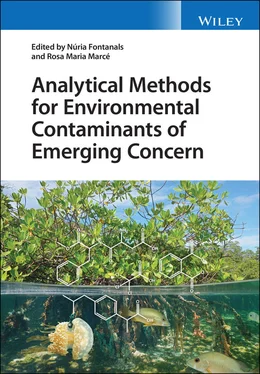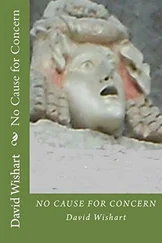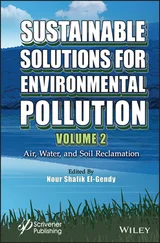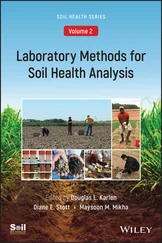Analytical Methods for Environmental Contaminants of Emerging Concern
Здесь есть возможность читать онлайн «Analytical Methods for Environmental Contaminants of Emerging Concern» — ознакомительный отрывок электронной книги совершенно бесплатно, а после прочтения отрывка купить полную версию. В некоторых случаях можно слушать аудио, скачать через торрент в формате fb2 и присутствует краткое содержание. Жанр: unrecognised, на английском языке. Описание произведения, (предисловие) а так же отзывы посетителей доступны на портале библиотеки ЛибКат.
- Название:Analytical Methods for Environmental Contaminants of Emerging Concern
- Автор:
- Жанр:
- Год:неизвестен
- ISBN:нет данных
- Рейтинг книги:5 / 5. Голосов: 1
-
Избранное:Добавить в избранное
- Отзывы:
-
Ваша оценка:
- 100
- 1
- 2
- 3
- 4
- 5
Analytical Methods for Environmental Contaminants of Emerging Concern: краткое содержание, описание и аннотация
Предлагаем к чтению аннотацию, описание, краткое содержание или предисловие (зависит от того, что написал сам автор книги «Analytical Methods for Environmental Contaminants of Emerging Concern»). Если вы не нашли необходимую информацию о книге — напишите в комментариях, мы постараемся отыскать её.
Provides the analytical methodology required to detect different families of organic compounds of emerging concern (CECs) from environmental samples Analytical Methods for Environmental Contaminants of Emerging Concern
Analytical Methods for Environmental Contaminants of Emerging Concern
Analytical Methods for Environmental Contaminants of Emerging Concern — читать онлайн ознакомительный отрывок
Ниже представлен текст книги, разбитый по страницам. Система сохранения места последней прочитанной страницы, позволяет с удобством читать онлайн бесплатно книгу «Analytical Methods for Environmental Contaminants of Emerging Concern», без необходимости каждый раз заново искать на чём Вы остановились. Поставьте закладку, и сможете в любой момент перейти на страницу, на которой закончили чтение.
Интервал:
Закладка:
In terms of recovery, most of the current analytical methods provided recoveries between 70% and 120%, although when multiresidue methods are developed, recoveries < 70% or > 120% are sometimes achieved. In the case of lower recoveries, if precision is < 20%, correction factors can be used for quantification purposes. In this sense, the use of generic methods, such as QuEChERS, which has been widely used in soils (see Table 1.2), provides acceptable recoveries (70–120%) for the simultaneous environmental monitoring of 218 pesticide residues in clay loam soil [99], or the quantitative extraction of parent pesticides, such as afidopyropen, and metabolites (recovery values: 85–100%) [98].
1.3.3 Hints and Tips
There are several hints and tips that should be considered in order to fulfill current legislation as well as to ensure reliable results:
Sample collection: Apply a statistical-based sampling procedure to ensure spatial and/or time variation and collect representative samples. Avoid compound degradation, selecting suitable storage and transport conditions. For air or water sampling, in addition to active sampling procedures, passive sampling is an interesting alternative, which is easy to deploy and minimum maintenance is required.
Extraction: Use sensitive and/or generic extraction procedures. Thus, for aqueous samples, SPE or SPME, selecting suitable sorbents, are the most widely extraction techniques to ensure lower LOQs as well as suitable recovery. For solid samples, such as biota and soils, although PLE, combining different sorbents depending on the target compounds, is a good option, nowadays, QuEChERS approach is the first choice, because of its versatility, wide range of application and simplicity. Depending on the complexity of the matrix, an additional clean-up step could be necessary. The final extract can be injected in both GC and LC equipment or it can easily be evaporated and redissolved in a GC solvent as ethyl acetate.
Analytical determination: Select LC or GC depending on the characteristics of the monitored compounds (GC for non-polar compounds and LC for polar pesticides). Either LC or GC should be coupled to QqQ, providing reliable, sensitive, fast and wide-scope analysis.
LRMS vs HRMS: Use QqQ (LRMS analyzer) for targeted analysis of pesticide residues in environmental samples, whereas HRMS ((Q)-Orbitrap or (Q)-TOF) must be utilized if suspect or unknown analysis is also required.
Data treatment: Well-set workflows and software are available for targeted analysis whereas when suspect or unknown analysis is performed, large raw data files are obtained, and high expertise and suitable software is needed for data interpretation and pesticide identification.
1.4 Future Directions and Challenges
Nowadays, in order to increase sample throughput and minimize the number of analyses that should be performed to get a comprehensive view of the presence of pesticides in the environment, current analytical methods are monitoring a higher number of pesticides. However, they have different physico-chemical properties (from non-polar to highly polar pesticides, and from low to high volatility) and this has hampered the development of an all-in-one approach, where a wide-scope analysis can be performed, analyzing pesticides and TPs. Therefore, the combination of different platforms (GC-MS & LC-MS) is a suitable approach to minimize the number of analyses to be carried out, covering a wide-scope of pesticides, although several compounds will still require specific methods to be detected (e.g. highly polar pesticides or metabolites).
Simplification of sample treatment is still necessary in order to minimize sample handling and therefore, error or bias associated to this step. Thus, automated methodologies that allow for monitoring of many priority substances and specific pollutants at concentrations below EQSs (e.g. water samples) are still demanding, because they are fast and cost-effective
One of the main challenges of environmental analytical chemistry is that there is a huge number of pesticides and/or TPs present in the environment, but many of them are still unknown because, for instance, the dissipation of the parent compounds has not been evaluated. Therefore, a targeted approach should be combined with suspect and unknown analyses to comprehensively assess chemical pollution related to pesticides. Special interest should be paid to the identification of new metabolites and/or TPs, and other emerging contaminants, and therefore the faster acquisition rate in HRMS analyzers and the development of efficient and user-friendly software are still needed to carry out a deconvolution process for the generation of clean mass spectra of coeluting peaks as well as an accurate putative identification. In this sense, the development of databases that include detected transformation products are needed to make this process much easier and this will facilitate the inclusion of TPs in future legislation.
Acknowledgments
Authors gratefully acknowledge to the Spanish Ministry of Economy and Competitiveness (MINECO), Spain and FEDER-EU (project ref. PID2019-106201RB-I00) for financial support. ID thanks the University of Almeria for the Hipatia postdoctoral contract. RLR acknowledges “Plan Propio of Investigation” of University of Almería, cofunded by CAJAMAR and the Operational Program Funds Europeans of Regional Development of Andalusia (2014–2020) (FEDER), for financial support.
Bibliography
1 1Carvalho, F.P. (2017). Pesticides, environment, and food safety. Food Energy Secur. 6: 48–60. doi: 10.1002/fes3.108.
2 2Pietrzak, D., Kania, J., Malina, G., Kmiecik, E., and Wator, K. (2019). Pesticides from the EU first and second watch lists in the water environment. Clean Soil Air Water 47: 1–13. doi: 10.1002/clen.201800376.
3 3Samsidar, A., Siddiquee, S., and Shaarani, S.M. (2018). A review of extraction, analytical and advanced methods for determination of pesticides in environment and foodstuffs. Trends Food Sci. Technol. 71: 188–201. doi: 10.1016/j.tifs.2017.11.011.
4 4Nasiri, M., Ahmadzadeh, H., and Amiri, A. (2020). Sample preparation and extraction methods for pesticides in aquatic environments: a review. Trends Anal. Chem. 123: 115772. doi: 10.1016/j.trac.2019.115772.
5 5Choudri, B.S., Charabi, Y., Al-Nasiri, N., and Al-Awadhi, T. (2020). Pesticides and herbicides. Water Environ. Res. 92: 1425–1432. doi: 10.1002/wer.1380.
6 6Ochoa, V. and Maestroni, B. (2018). Pesticides in water, soil, and sediments. In: Integrated Analytical Approaches for Pesticide Management, 1st ed. (ed. B. Maestroni and A. Cannavan), 133–147. Amsterdam: Elsevier. doi: 10.1016/B978-0-12-816155-5.00009-9.
7 7Ramakrishnan, B., Venkateswarlu, K., Sethunathan, N., and Megharaj, M. (2019). Local applications but global implications: can pesticides drive microorganisms to develop antimicrobial resistance? Sci. Total Environ. 654: 177–189. doi: 10.1016/j.scitotenv.2018.11.041.
8 8Hernández, F., Bakker, J., Bijlsma, L., de Boer, J., Botero-Coy, A.M., Bruinen de Bruin, Y., Fischer, S., Hollander, J., Kasprzyk-Hordern, B., Lamoree, M., López, F.J., Ter Laak, T.L., van Leerdam, J.A., Sancho, J.V., Schymanski, E.L., de Voogt, P., and Hogendoorn, E.A. (2019). The role of analytical chemistry in exposure science: focus on the aquatic environment. Chemosphere 222: 564–583. doi: 10.1016/j.chemosphere.2019.01.118.
9 9European Union (2008). Directive 2008/105/EC of the European Parliament and of the Council of 16 December 2008 on environmental quality standards in the field of water policy, amending and subsequently repealing Council Directives 82/176/EEC, 83/513/EEC, 84/156/EEC, 84/491/EEC. 86/280/EEC and amending Directive 2000/60/EC of the European Parliament and of the Council. Official Journal of the European Union L348: 84–97.
Читать дальшеИнтервал:
Закладка:
Похожие книги на «Analytical Methods for Environmental Contaminants of Emerging Concern»
Представляем Вашему вниманию похожие книги на «Analytical Methods for Environmental Contaminants of Emerging Concern» списком для выбора. Мы отобрали схожую по названию и смыслу литературу в надежде предоставить читателям больше вариантов отыскать новые, интересные, ещё непрочитанные произведения.
Обсуждение, отзывы о книге «Analytical Methods for Environmental Contaminants of Emerging Concern» и просто собственные мнения читателей. Оставьте ваши комментарии, напишите, что Вы думаете о произведении, его смысле или главных героях. Укажите что конкретно понравилось, а что нет, и почему Вы так считаете.












